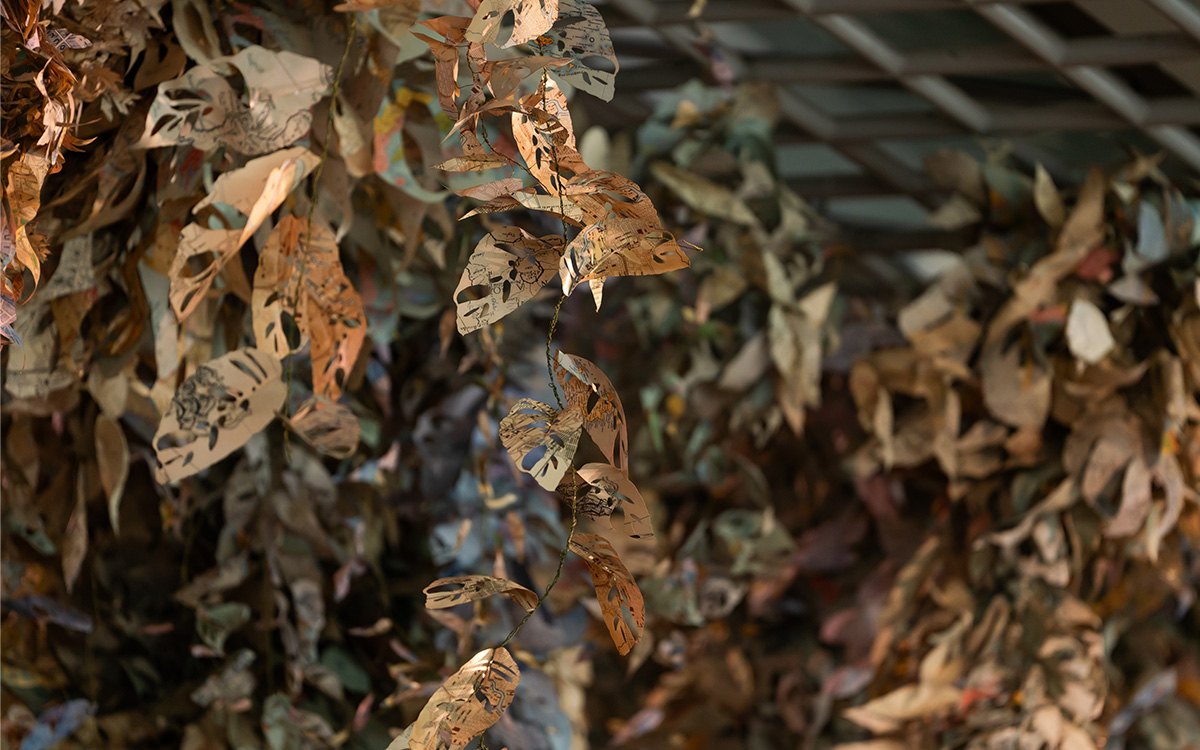

Creating a pastoral paradise in Esplanade
Published: 28 Mar 2024
Time taken : <5mins
Latin for a “pleasant place,” the phrase locus amoenus conjures notions of an escape into an ideal landscape. Echoing the idyllic implications of this phrase, Ryan Villamael endeavours to create a pastoral paradise within the Esplanade Concourse—with the vision that standing beneath the intricately-cut latticework might remind the observer of being in a greenhouse. Enveloping the space are meticulously crafted leaves shaped out of replicas of contemporary and archival geographical maps from the Philippines. Displaying maps on both sides of each leaf, the artwork merges multiple realities, bridging the historical with the present-day. Resembling foliage akin to the Monstera deliciosa, an invasive tropical plant renowned for its capacity to thrive and dominate any inhabited space, the installation explores themes surrounding territorial boundaries, colonisation, the creation of controlled environments, as well as the tangled relationships between the natural world and human intervention.

Installation view of <em>Locus Amoenus</em>, Ryan Villamael, 2024.
Many facets of the work have evolved over the years and with every iteration. Firstly, because the installation requires me to engage with other people in my process, each iteration of Locus Amoenus is as much about the work as it is about the local community—be it in a gallery or a biennale. As an example, for the iteration at Biwako Biennale, I stayed with a local family in Kyoto for a few weeks, and we somehow became part of each other’s lives throughout those weeks. We keep in touch even now. A big part of making Locus Amoenus becomes about me trying to convey what the show is about—that “pleasant place”—to the people I meet and the communities I find, despite language barriers and cultural differences. Each restaging is unique to the location, adapting to it, and consequently causing the work to evolve. The first Locus Amoenus at the Singapore Art Museum was installed in the glass porch, conveying a feeling of walking inside a greenhouse.

Detail of <em>Locus Amoenus</em> at MAIIAM Contemporary Art Museum, Thailand, 2018. Image courtesy of the artist.
Locus Amoenus at the Esplanade Concourse is the most public-facing version of the work. People walk through the area not necessarily to look at the art but as a thoroughfare to a performance or show. In this way, it offers something different to a diverse audience—some may pause to observe and derive meaning, while others may not. As a public installation, individuals are not compelled to engage with it, but its coexistence in the shared space makes the work more accessible. In conceiving the work, I wanted to avoid an obtrusive presence in the space and create an installation that organically exists in the Esplanade Concourse.

Installation view of <em>Locus Amoenus</em>, Ryan Villamael, 2024.
Archival materials are intriguing as they allow us to trace the development of perspectives or perceptions over time. Concerning maps in the historical context, an implicit aspect is that their creation often involved visualising something unknown or imagining places deemed exotic and unfamiliar to the colonisers.
On a personal note, my father left home when I was young. Growing up, looking at maps was my way of connecting with him—tracing the paths he might have travelled and attempting to see the places he may be living in. This fascination with maps revealed to me something profound about the way we use cartography. Maps serve as instruments of power as well as human longing. They are both political and personal, conveying national aspirations and individual ambitions. While cartographers strive to present geopolitical reality as accurately as possible, maps often become political and navigational instruments that offer only partial truths. These perspectives are shaped by socialisation, history and the cultures in which they originated. Maps, in essence, conceal as much as they reveal.
Despite experimenting with other materials, I think my process is still unchanged. I do not think it has really had that much of an impact. I approach wood, metal or any kind of material the same way I approach paper—it is still about having an idea and utilising a material. Cutting paper was one way to realise those ideas.

Detail of <em>Locus Amoenus</em>, Ryan Villamael, 2024.
Locus Amoenus by Ryan Villamael is on view at the Esplanade Concourse from 18 January to 7 July 2024.